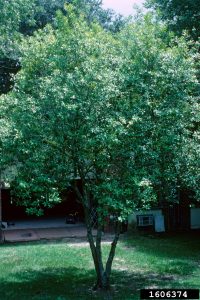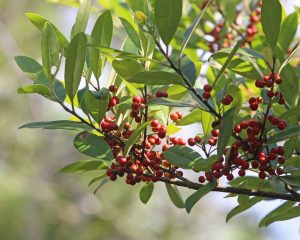Dahoon Holly, Ilex cassine

Photo by John Ruter, University of Georgia, Bugwood.org

Photo by John Ruter, University of Georgia, Bugwood.org

Photo by Mary Keim
Height: 20 to 40 feet
Spread: 8 to 30 feet
LANDSCAPE USE
Useful as a specimen tree, especially in narrow spaces, or as a large shrub. May be grouped with other male and female holly trees to ensure maximum fruit set. Well suited for difficult sites such as road and powerline rights-of-way, medians, the edges of retention ponds, and the borders of drainage swales and canal banks. Performs best in continually moist to seasonally wet areas.
FORM
An erect, evergreen tree with slender, spreading to ascending branches and a densely foliated, relatively narrow crown. Sometimes shrublike.
NATIVE RANGE
Edges of swamps, ponds, and wet hammocks. Virginia, south throughout Florida, and west to Louisiana.
CHARACTERISTICS
Flowers: White, individually small and inconspicuous, but borne in dense, showy clusters. Male and female flowers borne on separate trees. Spring.
Leaves: Alternate, oblong, leathery, shiny medium green above, paler below, to 5 inches long.
Fruit: A reddish orange to bright red drupe, ¼ inch in diameter, borne in dense, showy clusters. Male and female plants. Winter, but may persist for several months.
Bark: Smooth; light gray.
CULTURE
Soil: Prefers moist to wet, boggy, acid to slightly acid soil with pH 3.5 – 6.5.
Tolerant of low soil oxygen but can adapt to moist sites.
Exposure: full sun to part shade. Somewhat tolerant of salt air and quite shade tolerant.
Water: Irrigate and fertilize after transplanting. Plants situated in dry sites may require supplemental irrigation.
Hardiness Zones: 7 to 11.
Life Span: Moderate to short; less than 50 years.
BEST FEATURES including WILDLIFE SUPPORT
Showy, red-orange or bright red fruit, evergreen habit, narrow form, dense foliage, and tolerance of low soil oxygen. The fruit are a highly favored food source for fall migrating birds like Robins and Cedar Waxwings.
COMPANION PlANTS
Red Bays (Persea spp.), Scarlet Hibiscus (Hibiscus coccineus), Buttonbush (Cephalamhus occidentalis), Virginia Willow (Itea virginica), Sweetbay (Magnolia virginiana), Red Maple (Acer rubrum), Swamp Fern (Blechnum serrulatum), Pipestem (Agarista populifolia), Blue Beech (Carpinus caroliniana), Swamp Dogwood (Cornus foemina), Simpson’s Stopper (Myrcianthes fragrans), Walter’s Viburnum (Viburnum obovatum).
DISADVANTAGES
Spittle bugs and scales are sometimes bothersome. Otherwise hardy. Fruit production requires the presence of both a female and male plant.
CULTlVARS
Myrtle-leaved holly (Ilex myrtifolia) is sometimes considered a variety of I. cassine.
ALLERGENIC AND TOXIC PROPERTIES
Fruit is reportedly poisonous to humans, but is eaten by birds.
SIMILAR AND RELATED SPECIES
At least 11 hollies are native to Florida. At least six species are used in landscaping, including Possumhaw Holly (I. decidua), Myrtle-leafed Holly (I. myrtifolia), and Krug’s Holly (I. krugiana), the last of which is a South Florida specialty.